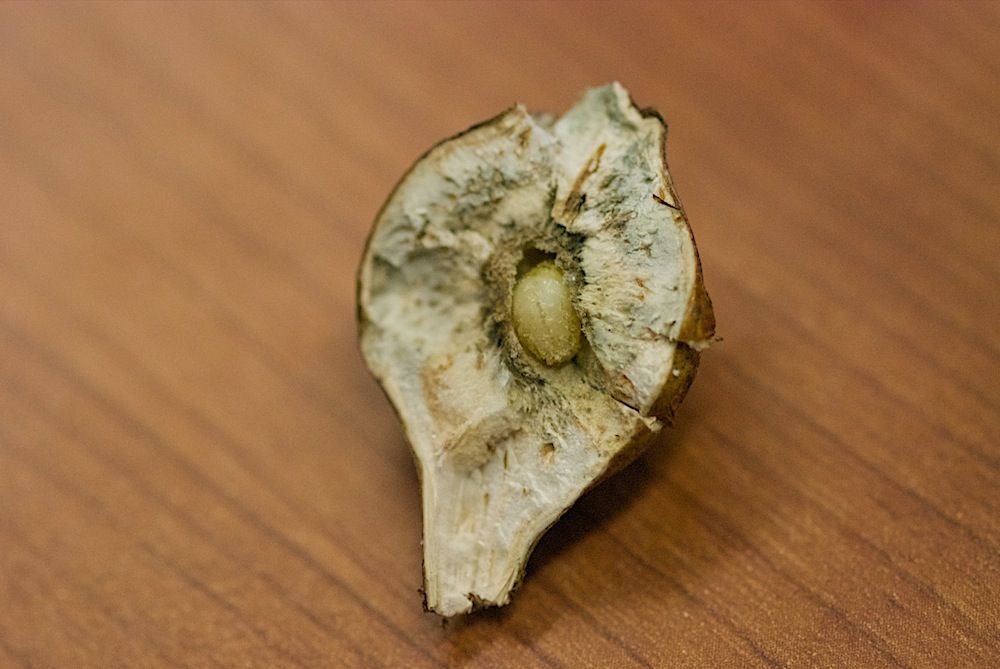Fat, Frozen Fly Babies Could Improve Biofuels

A surprising discovery of antifreeze fat in maggots could lead to the development of cold-hardy biofuels.
The maggot, or juvenile stage, of an insect called the goldenrod gall fly (Eurosta solidaginis) is the first insect found to use these special fatsto survive cold winters. This gall fly can stay alive in temperatures as low as negative 112 degrees Fahrenheit (negative 80 degrees Celsius), which is on par with the lowest temperatures ever recorded on Earth, said study researcher Brent Sinclair, a zoologist at the University of Western Ontario in Canada who studies the low-temperature biology of insects. The goldenrod gall fly's anti-freeze capabilities can make killing the insects for study difficult.
"To study their biology, we have to put them in liquid nitrogen, or otherwise they might survive," Sinclair told Live Science.
Accidental discovery
Katie Marshall, a postdoctoral researcher at the University of British Columbia, was working on her doctorate degree in Sinclair's lab when she stumbled across the freeze-resistant fat. Marshall was using new techniques to measure the different types of fat in the goldenrod gall fly. These insects live inside plants, causing their hosts to grow lumpy spheres called galls. These objects provide the developing larvae with nutrition and shelter. [Gallery: Dazzling Photos of Dew-Covered Insects]
Marshall's results revealed a mysterious substance that didn't fit any of the fat profiles the team was expecting. At first, Sinclair was inclined to dismiss the unknown substance, but Marshall's fiancé, a chemist, persuaded the researchers to find out what was really going on.
"At one point, Katie was literally walking the halls of the chemistry department, reading posters, to see if there was anyone who could measure what we were looking for," Sinclair said.
Sign up for the Live Science daily newsletter now
Get the world’s most fascinating discoveries delivered straight to your inbox.
Strange storage
The investigation revealed a rare find, identifying the mysterious fat molecules as acetylated triacylglycerols (acTAGs). Typically, animals store their energy in fats called long-chain triacylglycerols, which are exactly what they sound like: long, energy-packed chains. Chemically speaking, these long-chain triacylglycerols have a simple glycerol, or sugar alcohol, backbone. Attached to this sweet spine are three fuel-rich fatty acids.
In an acetylated triacylglycerol, a different clump of atoms called an acetyl group replaces one of the fatty acids. These acTAGs are common in some plants, like the bright red burning bush (Euonymus alatus), but are seen only rarely and in very trace amounts in a few animals.
"It's a lousy way to store energy, because you have less energy per molecule, [so] no one does it," Sinclair said.
Except for goldenrod gall flies. The maggoty pre-pupae, in their post-larval stage, begin converting their long-chain triacylgylcerols to acTAGs in fall. By mid-December, 46 percent of the insects' lipids are acTAGs. Subjecting the maggots to freeze-thaw cycles increased their levels of acTAGs, Sinclair said. The researchers report the findings today (April 30) in the Journal of Experimental Biology.
The beauty of acTAGs appears to be their freeze-resistance. The maggots' lipids remain liquid at temperatures that would freeze other insects solid, Sinclair said. A long-chain triacylglycerol goes solid at around 39 degrees F (4 degrees C). An acTAG, Sinclair said, would need to get below about 1 degree F (negative 17 degrees C) to turn from liquid to solid. The difference likely has to do with how the lipids interact with water in the cell, but the exact process remains unknown.
From flies to fuels
The study is a good example of basic, exploratory research yielding unexpected — and possibly useful — findings, Sinclair said. Biofuels are ill suited for cold temperatures, because they tend to solidify without additives.
But the goldenrod gall fly does something exciting: It converts its regular, freeze-susceptible long-chain fats to freeze-resistant acTAGs. If researchers can figure out how the insect does it, they might be able to mimic the process.
"The idea is we might be able to take regular fats we can produce in huge amounts from olives and coconuts and canola and whatever else, and we might be able to turn these fats into low-temperature fats whenever we want them," Sinclair said.
The findings could potentially have medical applications, as well, he added, perhaps leading to new ways to preserve cells such as human eggs or embryos. But those applications would be tougher, Sinclair said, because it's hard to coax a living cell to convert its fats from one type to another.
Follow Stephanie Pappas on Twitter and Google+. Follow us @livescience, Facebook & Google+. Original article on Live Science.

Stephanie Pappas is a contributing writer for Live Science, covering topics ranging from geoscience to archaeology to the human brain and behavior. She was previously a senior writer for Live Science but is now a freelancer based in Denver, Colorado, and regularly contributes to Scientific American and The Monitor, the monthly magazine of the American Psychological Association. Stephanie received a bachelor's degree in psychology from the University of South Carolina and a graduate certificate in science communication from the University of California, Santa Cruz.











